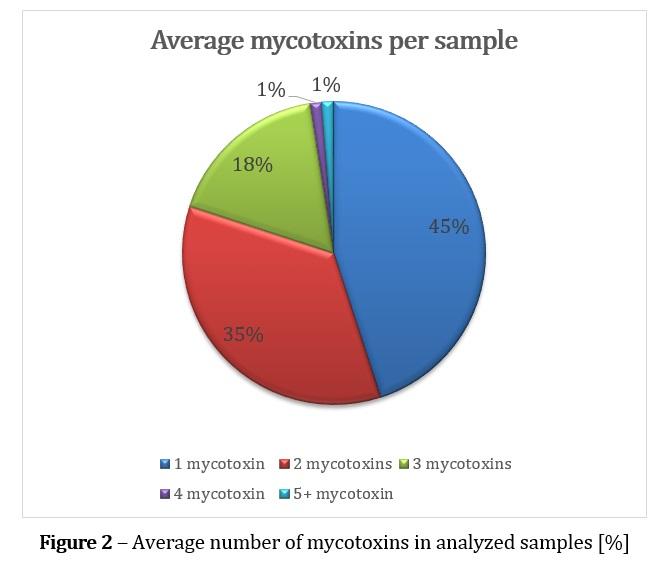The term “mycotoxins” defines secondary fungal metabolites that cause biochemical, physiologic and/or pathologic changes in other species, which include vertebrates, other animal groups, plants, and microbes. Mycotoxins have low molecular weight molecules (Mw <700) and are toxic in low concentrations (Haschek & Voss, 2013). Even though hundreds of compounds have been isolated and chemically characterized as mycotoxins, only approximately 50 have been studied in detail (CAST, 2003).
Picture 1 - Wheat harvested in Central Europe 2019
©Copyright: Radka Borutova, ADISSEO France
The 2019 Adisseo mycotoxin survey included 117 wheat samples from across Poland. The survey provided insight into the incidence of aflatoxin B1 (AfB1), zearalenone (ZEN), deoxynivalenol (DON), T-2 toxin, HT-2 toxin, fumonisin B1 (FB1), fumonisin B2 (FB2) and ochratoxin A (OTA). The wheat samples were collected directly from farms or animal feed production sites. Sample providers were advised to follow the principles of good sampling (Richard, 2000). Analytical personnel and laboratory staff were not involved and therefore did not influence the sampling process at any stage. All 117 samples were collected almost immediately after harvesting, so the probability of storage mycotoxins (e.g. OTA) developing was low. All 8 mycotoxins were analyzed by liquid chromatography tandem mass spectrometry (LC MS/MS). For the purpose of data analysis, non-detection levels were based on the limits of quantification (LOQ) of the test method for each mycotoxin: AfB1 <0,5 μg/kg; ZEN <10 μg/kg; DON <75 μg/kg; FB1 <125 μg/kg; FB2 <50 μg/kg; OTA <1 μg/kg; T-2 toxin < 4 μg/kg and HT-2 toxin <4 μg/kg.
Results
The results showed that 29% of the wheat samples were contaminated with DON. Only 3 % of samples contained ZEN.
The average concentrations of the recovered mycotoxins were medium to high. The maximum concentration of DON recovered in one of the samples was 2300 μg/kg, which was 8-times higher than the DON concentration of 247 μg/kg reported last year. As expected, few samples (1%) were contaminated with OTA, and the maximum concentration in a single sample was also low (45.5 ug/kg). The results also showed that 56% of the samples were contaminated with HT-2 toxin and the maximum concentration recovered was 283 μg/kg. None of the samples contained AfB1 and FB2. Unexpectedly, 3% of the samples were contaminated with FB1, a typical maize fusarium mycotoxin, and the maximum concentration recovered was 3750 μg/kg which was high and could be a consequence of global climate change (Moretti et al., 2019). The maximum concentration of ZEN recovered was 400 μg/kg which is a concern as can cause detrimental health effects in all animal species.
The levels of DON contamination recovered in wheat in 2019 were much higher than those recovered in 2018 and 2017 (Figure 1). The average number of positive samples in 2019 was approximately 2.5 times those of 2017 and 5 times higher than in 2018. In addition, the average concentration of samples contaminated with ZEN was approximately 3-times higher in 2019 than in 2017 and 2018 (Figure 1). In 2018, slightly fewer mycotoxins were detected (DON, ZEN, T-2 toxin and OTA) compared to 2019 where 6 mycotoxin types (DON, ZEN, T-2, HT-2, FB1 and OTA) were detected.
Conclusion
The Adisseo 2019 mycotoxin survey in Poland concluded that the wheat harvest was of medium quality in terms of mycotoxin contamination. This was a deterioration when compared to the previous year’s harvest. Based on the decline in the quality of the harvested wheat, as shown by the results of the 2019 wheat survey conducted immediately after the 2019 wheat harvest, the 2019 wheat crop in Poland should not automatically be considered safe for inclusion in finished feed rations for all animal species and a degree of vigilance is prudent.
Vigilance is always advisable as cereals in animal feeds originate from many sources. Some cereals (wheat, barley and basically all small grains) from some countries in South Europe (Romania, Hungary) which were harvested in 2019 have also been shown, like those from Poland, to be contaminated with high concentrations of DON.
The last possible line of defense is detoxification of mycotoxins in vivo. The addition of proven mycotoxin deactivators to animal feeds is a very common method of preventing mycotoxicosis and is an effective strategy to keep mycotoxin risk low under any and all conditions.
Adisseo is one of the world’s leading experts in feed additives. The group has 10 research centers and production sites based in Europe, USA and China to design, produce and market nutritional solutions for sustainable animal feed. With more than 2,200 employees, Adisseo serves around 3,900 customers in over 110 different countries through its global distribution network. Adisseo is one of the main subsidiaries of China National BlueStar, a leader in the Chinese chemical industry with nearly 21,500 employees and a turnover of 9,3 billion USD. Adisseo is listed on the Shanghai Stock Exchange. Find out more
here









.jpg&w=3840&q=75)